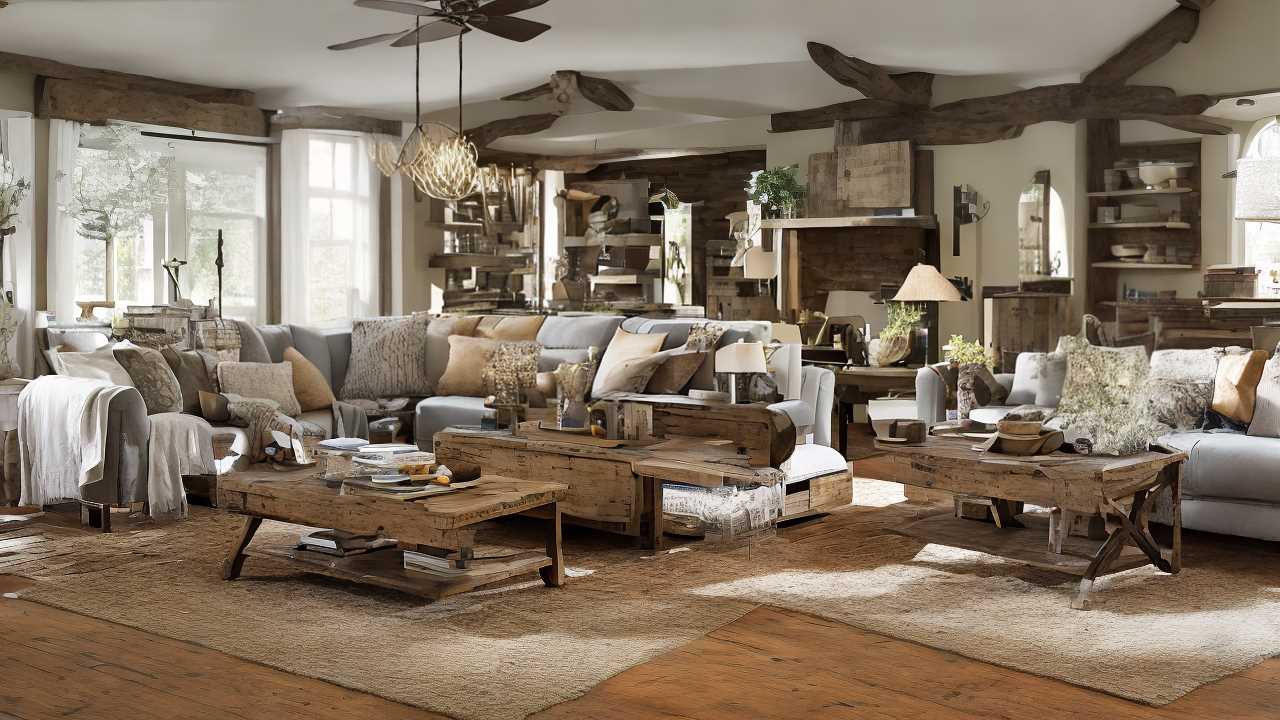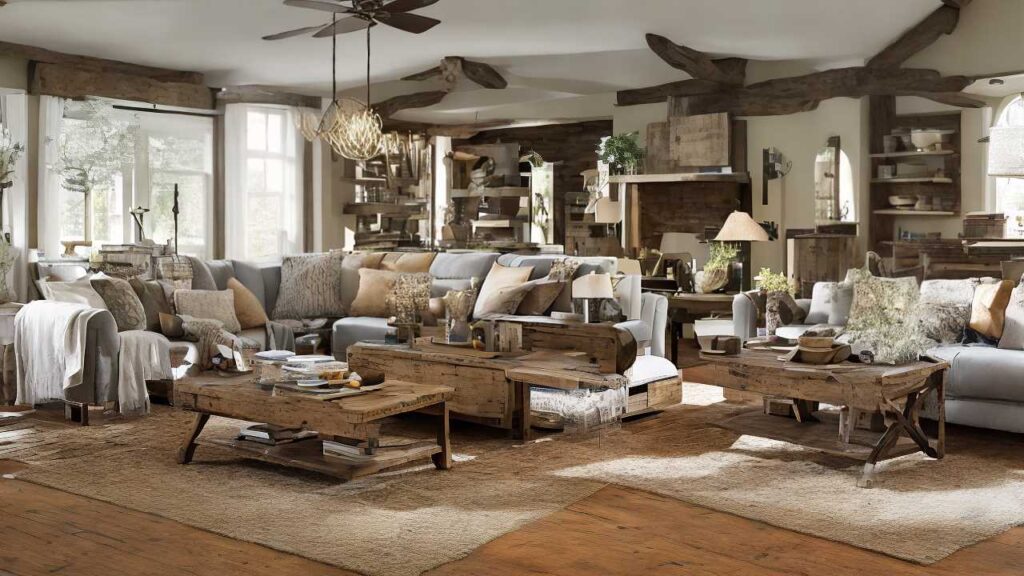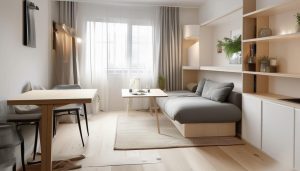
Table of Contents
ToggleThe Allure of Barnwood in Modern Interiors
There’s something inherently warm and inviting about the presence of barnwood in a home’s interior. Its rich texture and natural patina speak of a storied past, bringing a sense of depth and authenticity to contemporary spaces. As homeowners seek to create interiors that are not only stylish but also imbued with character, barnwood has emerged as a material of choice for those looking to infuse their living spaces with a touch of rustic elegance.
But what is it about barnwood that makes it so appealing? Is it the way it whispers tales of yesteryear, or the unique personality it imparts on every plank? Perhaps it’s the way it effortlessly harmonizes with both modern and traditional decor, bridging the gap between the old and the new. Barnwood’s versatility is unmatched; it can serve as a statement piece or a subtle backdrop, adapting to the homeowner’s vision with ease.
Moreover, the trend of using reclaimed wood aligns with the growing desire for sustainable living. Barnwood not only recycles material that would otherwise go to waste but also reduces the demand for new lumber. This aspect resonates with environmentally conscious individuals who are mindful of their ecological footprint. When you choose barnwood, you’re not just selecting a design element; you’re making a conscious decision to support the environment.
Imagine walking into a room graced with a barnwood accent wall or a kitchen adorned with a barnwood island. The texture and grain of the wood immediately draw the eye, creating a focal point that is both grounding and aesthetically pleasing. The wood’s inherent imperfections—its knots, nail holes, and saw marks—tell a story of resilience and survival, adding layers of visual interest that cannot be replicated by mass-produced materials.
In a world where individuality is cherished, barnwood offers a unique opportunity to personalize your space. Whether you’re looking to add a touch of history to your home or aiming to create a space that stands out, barnwood elements provide a canvas for self-expression. It’s a testament to the beauty that can be found in imperfection and the timeless appeal of materials that carry the weight of history within them.
The Environmental Upside of Reclaimed Wood
When we consider the environmental benefits of reclaimed wood, we’re looking at a solution that’s as kind to the planet as it is aesthetically pleasing. Reclaimed wood, by its very nature, is a recycled material. It comes from old structures, warehouses, and barns that have reached the end of their service life. By repurposing this wood, we give it a new lease on life, preventing it from ending up in landfills. But the advantages don’t stop there.
Think about the energy required to process new lumber. From the felling of trees to the transportation, milling, and finishing processes, each step consumes energy and contributes to carbon emissions. Reclaimed wood sidesteps much of this. It’s already been cut, shaped, and finished, which means the energy-intensive part of its journey is in the past. By opting for reclaimed wood, you’re not just selecting a unique piece of history for your home; you’re also reducing the demand for new timber, helping to preserve our forests and the biodiversity within them.
Let’s not forget the role of reclaimed wood in reducing deforestation. Our forests are vital to our survival; they’re the lungs of our planet, absorbing carbon dioxide and releasing oxygen. They’re also home to countless species of animals and plants. When you choose reclaimed wood, you’re taking a stand against the unnecessary cutting down of trees, and you’re doing your part to combat climate change. Isn’t it remarkable how a choice in home decor can have such far-reaching impacts?
Moreover, reclaimed wood often comes from trees that were part of old-growth forests. These trees are typically stronger, more durable, and have a tighter grain than those harvested today. By reusing this wood, we’re not only enjoying its superior quality but also respecting the time it took for these majestic trees to grow. It’s a way to honor the past while protecting our future.
In essence, incorporating reclaimed wood into your home is a powerful statement of environmental responsibility. It’s a choice that reflects a commitment to sustainability and a recognition of the importance of our natural resources. As we continue to seek ways to live in harmony with the environment, reclaimed wood stands out as a beautiful, practical, and ethical option that benefits both our homes and our planet.
Reclaimed Wood: History Meets Home Decor
Reclaimed wood brings with it a narrative that new materials simply cannot match. Each piece holds a story, a slice of history that’s etched into its very fibers. This historical richness is precisely what makes reclaimed wood a sought-after element in home decor. It’s not just about the aesthetic appeal; it’s about the tales of yore that these materials carry into contemporary living spaces.
Have you ever wondered about the journey of a reclaimed wood beam as it transitions from a century-old barn to your living room wall? The wood has witnessed generations, withstood the elements, and now serves a new purpose, adding a layer of depth and warmth to your home. It’s a conversation starter, a piece of the past preserved for the future. Homeowners and designers alike treasure reclaimed wood for this connection to tradition and history.
But it’s not just about the past. Reclaimed wood seamlessly blends with modern design, offering a textural contrast that can complement any style. Do you see the potential in pairing sleek, contemporary lines with the rustic charm of reclaimed timber? It’s a juxtaposition that can create a dynamic and inviting atmosphere in any room. The wood’s imperfections—its knots, grooves, and variations in color—are celebrated, not hidden, allowing the material’s authentic beauty to shine through.
Furthermore, when you choose reclaimed wood for your home, you’re participating in a story of sustainability. Each plank reused is one less cut from our living forests. It’s a choice that reflects a growing awareness of our environmental impact and a desire to repurpose with purpose. The wood’s durability is a testament to its time-tested resilience, promising to stand strong for years to come.
Incorporating reclaimed wood into your home decor does more than just beautify your space. It honors the craftsmanship of the past while embracing the principles of sustainable living. It’s a powerful statement that marries the elegance of history with the responsibility of the present. So, why not invite the legacy of reclaimed wood into your home and let its story continue in harmony with your own?
The Art of Distressing Timber for Antique Charm
The process of distressing timber is akin to an artist bringing a canvas to life. It’s a deliberate technique that instills new wood with the soulful essence of age and experience. For those who yearn for the antique charm without the years of waiting, distressing timber is the perfect solution. It’s a way to achieve that coveted, lived-in look that adds so much character and warmth to a space.
But what does it take to transform the unblemished surface of new wood into a masterpiece of time-worn beauty? It starts with the right tools and a bit of creativity. From hammers and chains to wire brushes and sandpaper, each instrument plays a role in etching history into the timber. The wood is intentionally marked, dented, and scuffed, replicating the natural wear and tear that occurs over decades. Staining then accentuates these marks, giving the wood an authentic patina that tells a story of a bygone era.
Why do we find this artificially aged wood so appealing? Perhaps it’s the way it reminds us of a simpler time, or how it brings a sense of resilience and endurance into our homes. Distressed timber has a way of connecting us to the past while still fitting seamlessly into modern living. It’s a tactile experience, where you can run your fingers over the grooves and imagine the history behind them.
Distressing isn’t just about making wood look old; it’s about crafting a narrative. When you incorporate distressed timber into your home, you’re not just adding a piece of furniture or an accent; you’re inviting a story into your living space. This story resonates with those who appreciate the journey as much as the destination. After all, isn’t there something inherently comforting about surrounding ourselves with materials that have stood the test of time?
In a world where everything feels increasingly transient, distressed timber offers a connection to permanence. It’s a celebration of craftsmanship and the beauty of aging. Whether it’s the centerpiece of a room or a subtle detail, distressed timber has the power to transform a space, making it feel at once timeless and inviting.
Exposed Beams for Architectural Depth
Exposed beams stand as a testament to architectural integrity, offering a visual feast that adds depth and structure to any interior. These rugged elements are more than just functional components; they are the bones of a building, providing a glimpse into the craftsmanship of days past. When integrated into modern design, exposed beams create a striking contrast that can elevate the aesthetic of a room to new heights.
But what is it about these structural elements that can transform a space from ordinary to extraordinary? Is it the way they draw the eye upward, enhancing the perception of space and volume? Or perhaps it’s the raw, unfinished look that evokes a sense of authenticity and grounding. Exposed beams carry with them an air of history and strength, effortlessly becoming the room’s focal point, around which all other design elements revolve.
Consider the versatility of exposed beams in your own home. Whether you’re aiming for a cozy, cabin-like feel or a bold, industrial vibe, these architectural features can be tailored to suit your vision. They can be left in their natural state, with their unique grain and knots on full display, or treated with stains and finishes to complement the surrounding decor. The choice is yours, and the possibilities are endless.
Integrating exposed beams into your living space also allows for creative exploration. Have you ever imagined hanging elegant pendant lights from a sturdy, weathered beam, or draping lush greenery across the expanse of a smooth, polished timber? These design choices invite an interplay of textures and materials that can enrich the ambiance of a room.
Ultimately, exposed beams are not just about aesthetics; they’re about honoring the architectural narrative of a space. They remind us of the time when buildings were erected with bare hands and simple tools, each beam hoisted into place with care and precision. By choosing to showcase these elements, you’re not just making a style statement; you’re preserving a piece of architectural heritage, allowing it to breathe new life into your home.
The Vintage Aesthetic of Weathered Planks
The allure of weathered planks lies in their ability to tell a story through their aged appearance. This vintage aesthetic, characterized by a naturally distressed look, brings a sense of history and rustic charm to any setting. Weathered planks are not just wood; they are canvases that display the passage of time through their faded colors, worn textures, and softened edges.
Why do we gravitate towards the vintage aesthetic of weathered planks? Is it perhaps because they evoke memories of a quaint countryside cottage or an old seaside boardwalk, each plank bearing the marks of sun, wind, and rain? These planks have a way of transporting us to a different time and place, creating a nostalgic atmosphere that resonates with our desire for authenticity in a world that often feels too polished and new.
Integrating weathered planks into your home decor does more than just achieve a visual effect; it brings an element of the outdoors inside. The silvery-gray patina of weathered wood can complement a variety of color schemes, providing a neutral backdrop that allows other design elements to shine. Whether used as flooring, wall cladding, or even as a unique headboard, weathered planks add a layer of texture and depth that is both tactile and visually appealing.
Moreover, working with weathered planks is a nod to sustainable design practices. By repurposing old wood, you’re participating in an eco-friendly approach to decorating. You’re giving new life to materials that might otherwise be discarded, reducing waste and contributing to a more sustainable future. It’s a choice that looks good and feels good, too.
In essence, the vintage aesthetic of weathered planks is about embracing imperfections and celebrating them as marks of character. It’s about creating a warm, inviting space that feels lived-in and loved. So, when you choose to incorporate weathered planks into your home, you’re not just following a trend; you’re making a statement that beauty can be found in the old, the weathered, and the well-worn.
The Story Behind Aged Siding in Home Design
Aged siding has a unique story to tell, one that is etched into every groove and weathered streak of its surface. This historical cladding material is more than just an aesthetic choice; it’s a piece of architectural storytelling that brings depth and soul to any home. As homeowners seek to create spaces with authentic narratives, aged siding has become a celebrated feature in home design, offering a visual and textural richness that new materials simply cannot replicate.
But what exactly gives aged siding its irresistible charm? Could it be the way it hints at the resilience of structures that have stood the test of time, bearing the marks of natural elements with grace? Perhaps it’s the way aged siding connects us to the past, serving as a reminder of the craftsmanship and materials of a bygone era. It’s the patina, the scars, and the faded paint that make aged siding a testament to history and a beacon of character.
Integrating aged siding into modern homes is not just about embracing vintage style; it’s about creating a dialogue between old and new. Imagine the warmth and texture it adds to a room, the way it can transform a bland space into one brimming with personality. Whether used as an accent wall, a kitchen backsplash, or exterior cladding, aged siding infuses a space with a sense of heritage and authenticity that is unrivaled.
Moreover, choosing aged siding is a sustainable design decision. By repurposing materials from demolished buildings, we reduce waste and give new life to wood that might otherwise be discarded. It’s a responsible choice that celebrates the beauty of reclaimed materials and supports a more circular economy in the building industry.
In essence, aged siding is not just about the visual impact it makes; it’s about the stories it carries and the sustainable practices it represents. It’s a celebration of endurance, a nod to the past, and a step towards a more thoughtful approach to home design. When you choose aged siding, you’re not just selecting a material; you’re embracing a piece of history and making it a part of your own home’s story.
The Functional Beauty of Barn Doors
Barn doors are a striking blend of practicality and aesthetic appeal, a design element that serves as both a focal point and a space-saving solution. Their robust construction and smooth sliding mechanism make them an ideal choice for those who appreciate the fusion of form and function. But barn doors are more than just a trendy interior feature; they are a nod to rustic heritage with a modern twist, offering a unique way to divide spaces without sacrificing style.
Have you ever considered the versatility of barn doors in your own home? They can be customized to fit any decor style, from sleek and contemporary to cozy and traditional. The beauty of barn doors lies in their ability to adapt to your personal taste. You can choose from a variety of woods, finishes, and hardware to create a look that’s entirely your own. And let’s not forget, installing a barn door is a statement in itself, showcasing your commitment to both design and functionality.
But what sets barn doors apart from conventional swinging doors? Is it their ability to save precious floor space, or the ease with which they can transform a room’s ambiance? Perhaps it’s the way they effortlessly glide along their tracks, providing a seamless transition from one area to another. Barn doors invite you to rethink the way you interact with your living space, offering a dynamic and flexible approach to interior design.
Moreover, barn doors can serve as a canvas for your creativity. Imagine a beautifully distressed barn door that doubles as a piece of art, or a brightly painted one that adds a pop of color to an otherwise neutral palette. The possibilities are endless, and the choice is yours to make a statement that reflects your unique style and vision.
In essence, barn doors are a testament to the harmony of beauty and utility. They remind us that design can be both visually stunning and incredibly practical. Whether you’re looking to create a private retreat or an open-concept layout, barn doors offer a solution that is as smart as it is stylish. So why not slide into the world of barn doors and discover the functional beauty they can bring to your home?
Mantels and Floating Shelves: Rustic Meets Practical
In the intersection of rustic charm and practical design, mantels and floating shelves stand out as versatile elements that enhance any room’s decor. A mantel, traditionally the centerpiece of a living room, offers both a nod to classic architecture and a platform for personal expression. Floating shelves, on the other hand, provide a sleek and modern way to display decor and store essentials without compromising floor space.
Why do mantels and floating shelves resonate so deeply with both homeowners and designers? Is it because they offer a perfect stage to showcase life’s treasures, from family photos to heirloom vases? Or is it the way they can be customized to fit any style, from a rough-hewn barnwood mantel that anchors a cozy fireplace to minimalist floating shelves that blend seamlessly into a contemporary space?
The beauty of these wooden accents lies in their dual purpose. Mantels serve as a focal point, drawing the eye and anchoring the aesthetic of a room. They invite you to celebrate seasons and holidays with ever-changing decor. Floating shelves, with their clean lines and hidden brackets, offer an unobtrusive storage solution that keeps your space tidy and your cherished items on display.
Moreover, the use of barnwood or reclaimed wood for mantels and shelves adds a layer of eco-friendly appeal. By choosing sustainable materials, you’re not only creating a beautiful home but also making a responsible choice for the planet. It’s a small decision that reflects a larger commitment to environmental stewardship.
In essence, mantels and floating shelves are more than just pieces of wood affixed to a wall; they are a testament to the harmony of form and function. They allow you to infuse your space with character and history while serving practical needs. So, whether you’re looking to create a rustic retreat or a modern haven, consider the simple elegance of barnwood mantels and floating shelves to elevate your home’s design.
Wood Paneling and Ceiling Beams as Transformative Elements
Wood paneling and ceiling beams possess an extraordinary power to transform any interior into a space with distinct character and architectural interest. These elements, often overlooked, can dramatically alter the perception and feel of a room, introducing texture, warmth, and a natural aesthetic that can complement a range of design styles. Whether you’re aiming for a cozy, cabin-like atmosphere or a refined, elegant space, wood paneling and beams are versatile enough to achieve your desired effect.
Why do wood paneling and ceiling beams have such a profound impact on the ambiance of a room? Is it the way they can make a high ceiling feel more intimate, or how they can add dimension to a flat wall? Wood paneling can be as subtle or as bold as you like, with options ranging from sleek, modern slats to rustic, reclaimed boards. Ceiling beams, on the other hand, draw the eye upward and can create the illusion of more space or add a sense of grandeur to an otherwise simple room.
The choice of wood and finish for paneling and beams can also significantly influence the room’s decor. Lighter woods can brighten a space and lend an air of casual comfort, while darker woods can create a feeling of luxury and timelessness. The beauty of these wooden features is that they can be tailored to fit your personal style and the unique architectural details of your home.
Moreover, incorporating wood paneling and beams into your home is not just about aesthetics; it’s also about embracing the durability and longevity of natural materials. Wood has been a staple in construction for centuries, and its enduring appeal is a testament to its strength and resilience. By choosing wood for your interior design, you’re investing in a material that will stand the test of time, both in style and substance.
In essence, wood paneling and ceiling beams are transformative design elements that can elevate a room from ordinary to extraordinary. They offer a way to infuse your space with natural beauty and architectural depth, creating a home that feels both grounded and inspired. So, why not explore the potential of wood to transform your living environment into a place of comfort, elegance, and enduring charm?
The Enduring Beauty of Barnwood Hardwood Floors
Barnwood hardwood floors are the epitome of timeless beauty and durability in home design. Their rich textures and earthy tones bring a sense of history and warmth to any space, creating a foundation that is as sturdy as it is stunning. These floors are not just about making a statement; they’re about investing in a surface that will endure the rigors of daily life while aging gracefully.
Why do barnwood floors continue to captivate the hearts of homeowners and designers alike? Is it the way they offer a second life to the majestic trees that once stood in our countryside, or the unique character they bring with their imperfections and signs of wear? Each plank tells a story, a narrative of years gone by, making every floor one-of-a-kind. The natural variations in grain, color, and texture mean that no two barnwood floors are exactly alike, allowing you to enjoy a piece of nature’s artistry in your own home.
The practical advantages of barnwood floors are just as compelling as their aesthetic appeal. Known for their strength and resilience, these floors can withstand the demands of heavy foot traffic, making them an ideal choice for both residential and commercial spaces. And let’s not overlook the ease of maintenance; barnwood’s rugged charm is forgiving of the occasional scuff or scratch, ensuring that your floors remain beautiful with minimal effort.
Moreover, choosing barnwood for your flooring is a sustainable choice that respects our planet’s resources. By repurposing wood from old barns and buildings, you’re reducing the need for new lumber, helping to conserve our forests and reduce waste. It’s a way to honor the past while being mindful of the future.
In essence, barnwood hardwood floors are a testament to the harmony of beauty, function, and sustainability. They offer a sense of continuity from past to present, grounding your home with materials that have stood the test of time. So, when considering new flooring, why not opt for the enduring beauty of barnwood and let its history become a part of your home’s story?
Why Barnwood Continues to Captivate Homeowners
The enduring appeal of barnwood in home design is a phenomenon that speaks to the heart of authenticity and nostalgia. Homeowners are captivated by the raw beauty and storied past that barnwood brings into their living spaces. But what is it about this rugged, reclaimed material that continues to hold such allure in an age where modern materials abound?
Is it the rich tapestry of history embedded in each piece of barnwood that resonates so deeply with those who integrate it into their homes? Each mark, nail hole, and grain pattern tells a tale of a time when craftsmanship and longevity were the hallmarks of construction. Barnwood connects us to the agricultural heritage of our past, serving as a tangible link to the generations that have come before us. It’s this connection to history and heritage that makes barnwood a timeless choice.
Beyond its aesthetic appeal, barnwood offers a versatility that is unmatched. It can be fashioned into virtually any element of home decor, from flooring and accent walls to furniture and art pieces. Its adaptability allows homeowners to craft spaces that are truly unique, reflecting their personal style and the architectural character of their homes. Whether you’re aiming for a rustic farmhouse vibe or a sleek industrial look, barnwood can be the material that ties your vision together.
Moreover, the trend of using barnwood is rooted in a growing consciousness about sustainability and eco-friendly living. By repurposing wood from old structures, homeowners are making an environmentally responsible choice. They’re reducing waste and minimizing the demand for new lumber, all while giving new life to materials with a storied past. It’s a win-win for both the homeowner and the environment.
In essence, barnwood continues to captivate homeowners because it offers a unique combination of beauty, versatility, and sustainability. It’s a material that not only looks good but also feels good to use, knowing that it carries with it a legacy of both history and environmental stewardship. As we look to the future of home design, it’s clear that barnwood will remain a beloved choice for those seeking to add depth and character to their homes.
Incorporating barnwood elements into your home decor is more than a trend; it’s a celebration of history, sustainability, and timeless beauty. The unique character and rustic elegance that barnwood brings to interiors is unmatched, offering a special blend of warmth, authenticity, and environmental consciousness. Whether you are renovating a space or building from scratch, consider the charm and character that barnwood can provide. It’s a choice that will not only enrich your living environment but will also pay homage to the past while embracing eco-friendly practices for the future.
Can barnwood be used in outdoor settings?
Yes, barnwood can be used outdoors, but it requires proper treatment and sealing to protect it from the elements. It’s important to choose barnwood that has been appropriately treated for outdoor use to ensure longevity.
How do you maintain and care for barnwood features?
Maintaining barnwood features involves regular dusting and occasional gentle cleaning with a damp cloth. Avoid harsh chemicals and water exposure to preserve the natural patina of the wood.
Is reclaimed barnwood flooring more durable than traditional hardwood flooring?
Reclaimed barnwood flooring is often more durable than traditional hardwood because it comes from old-growth trees, which typically have tighter grain patterns and have already withstood the test of time.
Are barnwood elements suitable for all design styles?
Barnwood elements are incredibly versatile and can complement a wide range of design styles, from rustic to modern, depending on how they are incorporated and finished.
What makes barnwood a sustainable choice for home decor?
Barnwood is a sustainable choice because it repurposes existing wood from old structures, reducing the need for new lumber and minimizing waste, thus contributing to a more sustainable approach to building and decorating.





